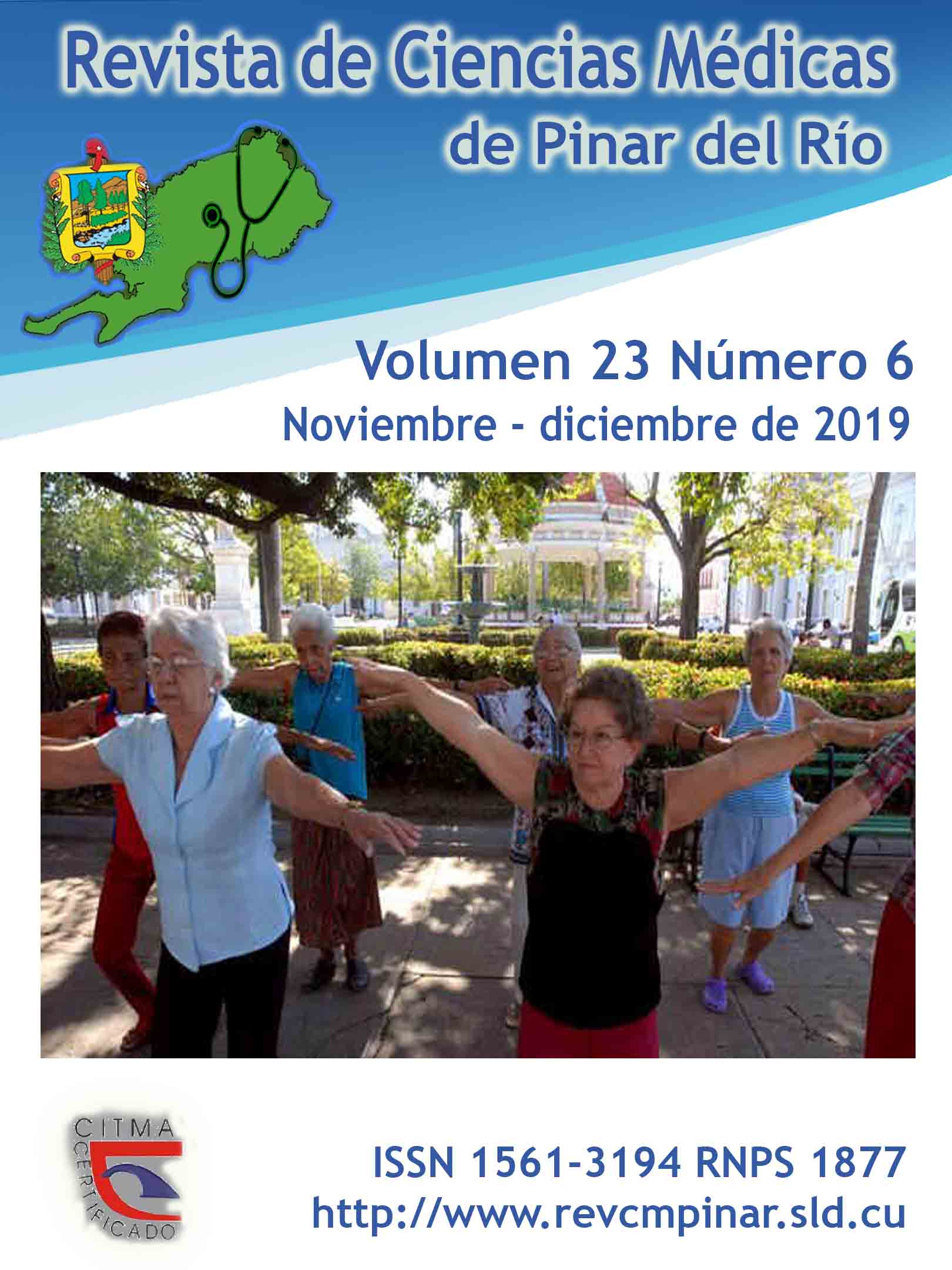Síndrome de Klippel y Trénaunay
Palabras clave:
MALFORMACIONES VASCULARES, HIPEROSTOSIS, CROMOSOMAS /anomalías, ATENCIÓN AL PACIENTE, ESCLEROTERAPIA.Resumen
Introducción: el síndrome de Klippel y Trénaunay es el resultado de un trastorno de desarrollo embrionario de los tejidos mesodérmicos que afectan la angiogénesis en diferentes etapas, posiblemente después de una lesión intrauterina, por lo que aparece con muy poca frecuencia en la adultez.
Objetivo: describir los hallazgos clínicos, de laboratorio, de imágenes y la evolución de una adulta joven con síndrome de Klippel y Trénaunay.
Presentación del caso: se trata de una mujer de 31 años de edad que acude al cuerpo de guardia por presentar sangramiento rectal y edema en miembro inferior izquierdo que abarca el muslo. Al examen físico se constata nevo vascular ubicado en la extremidad inferior izquierda y venas varicosas que refiere la paciente tener desde edades muy tempranas de su vida. Los exámenes de imágenes confirmaron el diagnóstico de un síndrome Klippel y Trénaunay. Recibió tratamiento según protocolo logrando mejoría clínica evidente.
Conclusión: el adecuado diagnóstico de este síndrome permitió un seguimiento y tratamiento médico adecuados por el equipo multidisciplinario responsable logrando así una mejor calidad de vida del paciente.
Descargas
Citas
1. Klippel M, Trénaunay P. Memoires originaux: du naevus variqueux osteo-hypertrophique. Arch Gen Med.1900; 3:641-72.
2. Wassef M, Blei F, Adams D, Alomari A, Baselga E, Berenstein A, et al. Vascular anomalies classification: recommendations from the International Society for the Study of Vascular Anomalies. Pediatrics [Internet]. 2015 [citado 14/02/2019]; 136(1):[aprox. 11p.]. Disponible en: https://pediatrics.aappublications.org/content/136/1/e203.full
3. Steiner JE, Drolet BA. Classification of vascular anomalies: An update. Semin Intervent Radiol [Internet]. 2017 [citado 14/02/2019]; 34(3): [aprox. 7p.]. Disponible en: https://www.thieme-connect.com/products/ejournals/html/10.1055/s-0037-1604295
4. Longman R. Klippel-Trénaunay-Weber Syndrome. En: Copel J, D'Alton M, Feltovich H, et al, editores. Obstetric Imaging: Fetal Diagnosis and Care. 2da Ed. USA, Elsevier; 2018. p. 554-556.
5. Vahidnezhad H, Youssefian L, Uitto J. Klippel–Trenaunay syndrome belongs to the PIK3CA‐related overgrowth spectrum (PROS). Exp Dermatol. [Internet]. 2016 Jan [citado 14/02/2019]; 25(1): [aprox. 2p.]. Disponible en: https://onlinelibrary.wiley.com/doi/full/10.1111/exd.12826
6. Yeung KS, Ip JJ, Chow CP, Kuong EY, Tam PK, Chan GC, et al. Somatic PIK3CA mutations in seven patients with PIK3CA‐related overgrowth spectrum. Am J Med Genet A [Internet]. 2017 [citado 14/02/2019]; 173(4): [aprox. 1p.]. Disponible en: https://www.ncbi.nlm.nih.gov/pubmed/28328134
7. Castel P, Carmona FJ, Grego-Bessa J, Berger MF, Viale A, Anderson KV, et al. Somatic PIK3CA mutations as a driver of sporadic venous malformations. Sci Transl Med. [Internet]. 2016 [citado 10/02/2019]; 8(332):[aprox. 10p.]. Disponible en: http://stm.sciencemag.org/content/8/332/332ra42.full
8. Baskerville PA, Ackroyd JS, Browse NL. The etiology of the Klippel-Trénaunay syndrome. Ann Surg. [Internet]. 1985 [citado 10/02/2019]; 202(5): [aprox. 3p.]. Disponible en: https://www.ncbi.nlm.nih.gov/pmc/articles/PMC1250978/
9. Wang SK, Drucker NA, Gupta AK, Marshalleck FE, Dalsing MC. Diagnosis and management of the venous malformations of Klippel-Trénaunay syndrome. J Vasc Surg: Ven Lymph Dis. [Internet]. 2017 [citado 14/02/2019]; 5(4):[aprox. 8p.]. Disponible en: http://sci-hub.tw/https://doi.org/10.1016/j.jvsv.2016.10.084
10. Frieden IJ, Chu DH. Klippel-Trénaunay syndrome: clinical manifestations, diagnosis and management. UptoDate. [Internet]. 2016 [citado 14/02/2019]; 2016: [aprox. 21p.]. Disponible en: https://www.uptodate.com/contents/klippel-Trénaunay-syndrome-clinical-manifestations-diagnosis-and-management
11. Marunraj G, Balaji V, Thulasikumar G, Anusha R. A rare case of Klippel-Trénaunay syndrome with thrombosed venous mass. Int Surg J. [Internet]. 2016 [citado 09/02/2019]; 2(3):[aprox. 3p.]. Disponible en: https://ijsurgery.com/index.php/isj/article/view/664/662
12. Sepulveda A, Soriano H, Espino A. Gastrointestinal tract involvement in Klippel–Trénaunay syndrome. Lancet Gastroenterol Hepatol. [Internet]. 2018 [citado 09/02/2019]; 3(7): [aprox. 1p.]. Disponible en: http://sci-hub.tw/https://doi.org/10.1016/S2468-1253%2818%2930140-7
13. Al-Salman MM. Klippel–Trénaunay syndrome: clinical features, complications, and management. Surg Today. [Internet]. 1997 [citado 14/02/2019]; 27(8): [aprox. 5p.]. Disponible en: http://sci-hub.tw/https://doi.org/10.1007/BF02384987
14. KTS Working Group. Clinical practice guidelines for Klippel-Trénaunay Syndrome. [Internet]. Boston Children’s Hospital; 2016. [citado 05/02/2019]. Disponible en: https://k-t.org/assets/images/content/BCH-Klippel-Trenaunay-Syndrome-Management-Guidelines-1-6-2016.pdf
Publicado
Cómo citar
Número
Sección
Licencia
Aquellos autores/as que tengan publicaciones con esta revista, aceptan los términos siguientes:- Los autores/as conservarán sus derechos de autor y garantizarán a la revista el derecho de primera publicación de su obra, el cuál estará simultáneamente sujeto a la Licencia de reconocimiento de Creative Commons que permite a terceros compartir la obra siempre que se indique su autor y su primera publicación esta revista.
- Los autores/as podrán adoptar otros acuerdos de licencia no exclusiva de distribución de la versión de la obra publicada (p. ej.: depositarla en un archivo telemático institucional o publicarla en un volumen monográfico) siempre que se indique la publicación inicial en esta revista.
- Se permite y recomienda a los autores/as difundir su obra a través de Internet (p. ej.: en archivos telemáticos institucionales o en su página web) antes y durante el proceso de envío, lo cual puede producir intercambios interesantes y aumentar las citas de la obra publicada. (Véase El efecto del acceso abierto).



